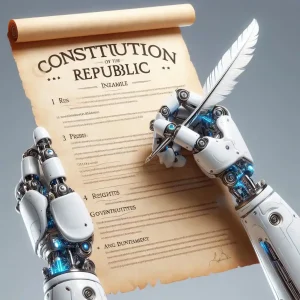Google has developed a “robot constitution” for its artificial intelligence (AI) robots to prevent them from harming humans.
The company’s DeepMind robotics team announced the development of three new advances on January 4, 2024, that it says will help robots make faster, better, and safer decisions in natural environments. One of these advances is a data collection system called AutoRT, which uses a “safety-focused prompt” to prevent robots from being instructed to perform tasks that could harm humans.

AutoRT uses a combination of visual language models (VLMs), large language models (LLMs), and robot control models (RT-1 or RT-2) to collect training data for robots in new environments. It can safely command up to 20 robots at a time, each of which is equipped with a camera, a robotic arm, and a mobile base. The VLMs help the robots understand their surroundings and the objects in their field of view, while the LLMs generate a list of creative tasks that the robots could perform, such as placing snacks on a table or choosing the right task for the robot to perform.
Although AutoRT is a data collection system, it has a safety guard, one of which is the “robot constitution.” Google’s “robot constitution” uses a “safety-focused prompt” to instruct the LLMs to avoid choosing tasks that involve humans, animals, sharp objects, or even electrical appliances. The “robot constitution” is inspired by the Three Laws of Robotics by science fiction author Isaac Asimov, which state that a robot may not injure a human being or, through inaction, allow a human being to come to harm; a robot must obey the orders given it by human beings except where such orders would conflict with the First Law; and a robot must protect its own existence as long as such protection does not conflict with the First or Second Law.
To further enhance safety, DeepMind programmed the robots to automatically stop if the force on any of their joints exceeds a certain threshold. The company also installed a physical kill switch that allows humans to stop the robots from operating.
Over the course of seven months, Google deployed 52 unique robots in different office buildings and collected a dataset of 77,000 robot trials, including 6,650 unique tasks. According to The Verge, some of the robots were controlled by human operators remotely, while others were operated autonomously using Google’s Robotic Transformer AI learning model.
DeepMind’s other new technologies include the SARA-RT neural network architecture, which is designed to make existing Robotic Transformer AI learning models faster and more accurate. The company also announced the RT-Trajectory model, which helps robots better perform specific physical tasks, such as wiping a table.
For humans, understanding how to wipe a table is intuitive, but robots can interpret instructions in a variety of ways to translate them into actual physical actions. Traditionally, training robotic arms has relied on mapping abstract natural language (such as “wipe the table”) to specific actions, such as closing the gripper, moving left, and moving right. However, this makes it difficult for models to generalize to new tasks.
The RT-Trajectory model automatically adds visual contours that describe the robot’s movements to training videos. RT-Trajectory takes each video in the training dataset and overlays it with a 2D trajectory sketch of the robot arm’s gripper as it performs the task. These trajectories provide low-level, practical visual cues for the model to learn robot control strategies.
DeepMind says that RT-Trajectory is able to teach robots “how to do” tasks by interpreting the specific robot movements contained in videos or sketches. The system is versatile, as it can also create trajectories by watching humans demonstrate tasks, or even accept hand-drawn sketches. It can also be easily adapted to different robot platforms.
Special statement: This article is reprinted solely for the purpose of disseminating information, and does not necessarily represent the views of this website or confirm the authenticity of its content. If other media, websites, or individuals use the content of this website for reprinting, they must retain the source indicated by this website and assume copyright and other legal responsibilities. If the author does not want to be reprinted or contact the reprint fee, please contact us.
